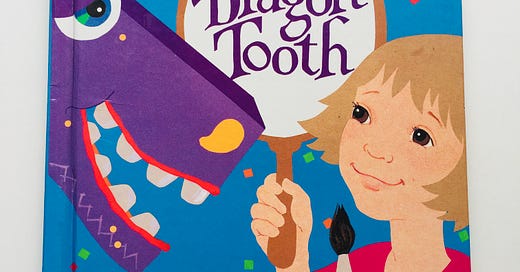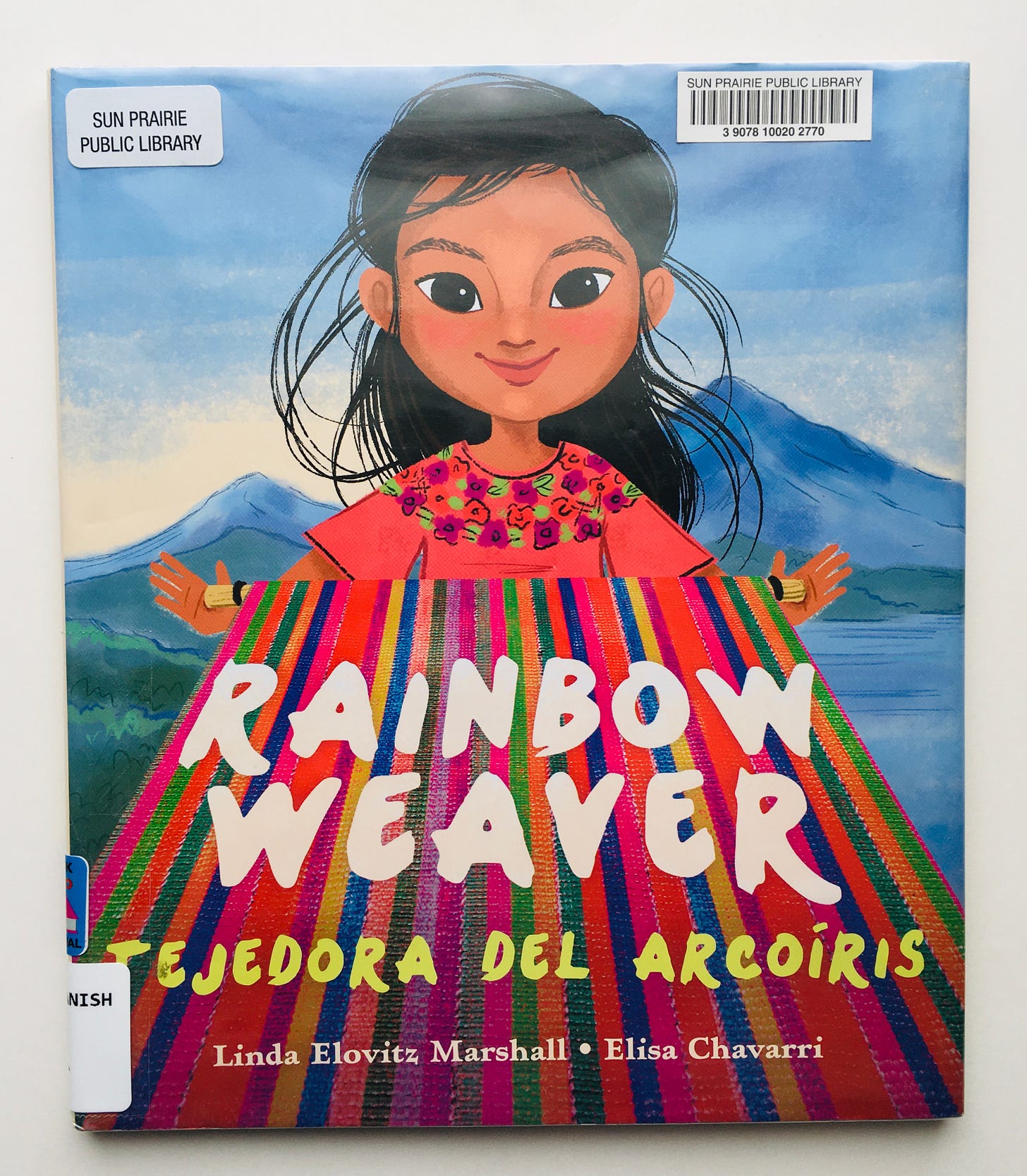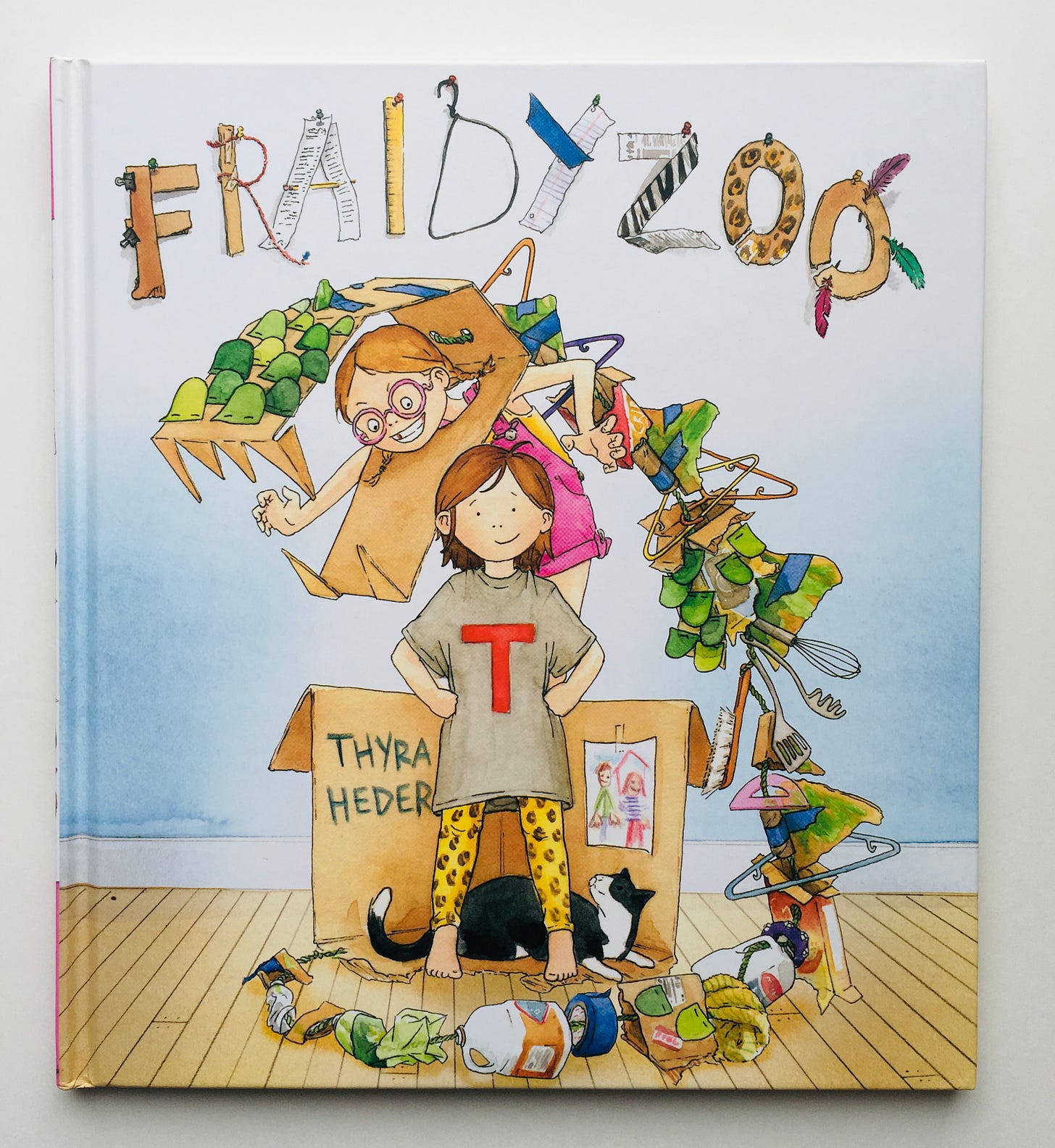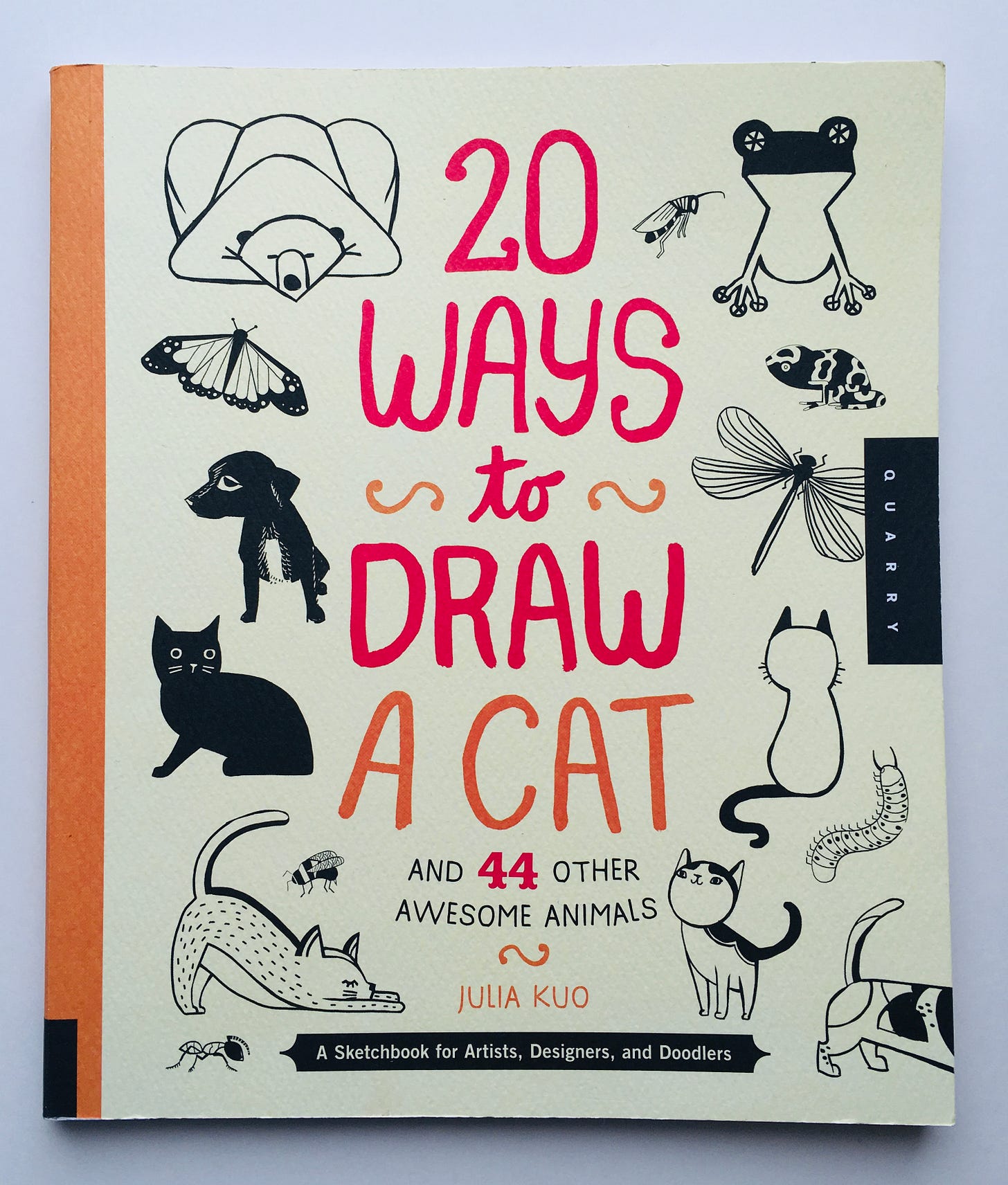Can we read? No. 35
Hello! Let’s get right to it today.
Dragon Tooth by Cathryn Falwell (1996)
Someday I will make a list of my favorite children’s book authors and illustrators, and Cathryn Falwell will be solidly on it — I have reviewed many of her titles by now (in issue No. 1, No. 17, my special edition on fall, and my special edition on Christmas, Part 1 because we love her so. I’ve considered it: why is she so good? What is it about her books that resonates so much? Dragon Tooth is a perfect illustration (no pun intended — well, maybe just a little) of my answer: not only does she show real, ordinary children living their real, ordinary lives, she captures their wondrous ability to use imagination, creativity, and play to process the things they’re going through and how they feel about it. In this title Sara’s tooth is loose and she’s kind of stressed out about it. Her father offers to help her but she angrily refuses and instead retreats to her garage to construct — out of garbage and found objects — a dragon who is dealing with the same problem. When Sara helps the dragon (my favorite part is his egg carton teeth), it seems to unstick something inside her that allows her to return indoors and receive her father’s help. The message here that children are able to work through their own problems if given the space, time, and support is a powerful one (and one, I believe, children need to hear). Falwell’s cut-paper and recycled-scrap illustrations show a girl who is imaginative, capable, and entirely human. Whether it’s losing a tooth, making a drawing of one’s own, creating a quiet space in the backyard in which to find some peace, Falwell’s stories are gentle, wonderful, and always just right.
Rainbow Weaver / Tejedora de Arcoiris by Linda Elovitz Marshall, illustrated by Elisa Chavarri (2016)
Weaving is fascinating, at least to me, but I’m not all that good at it, so when I discovered this title I was excited (and hopeful I might learn a thing or two). I’m not sure that happened but from the moment we cracked open this bilingual book, we were charmed by Chavarri’s bright, saturated illustrations of a young Mayan girl and her mother, who is weaving “thread into fabric as beautiful as a rainbow” high in the Guatemalan mountains, following the two-thousand-year-old artistic tradition of the Mayan craftspeople. Ixchel asks if she may weave too but her mother tells her she is still too young, there is no extra thread, and these cloths must be sold at the market to pay for school and books. Ixchel, like any determined child denied her desire, spends approximately 30 seconds being upset before applying herself to the problem: first, she builds herself a loom. Then, she looks around her world for whatever she might reuse as thread: tall blades of grass, wool left on branches by sheep going up the mountain, plastic bags people have left on the ground. She fails and fails until she finally lands on a solution — one that’s beautiful in multiple ways. This is, at the very least, the story of a maker — Ixchel figures out a way to make something she doesn’t have by working what what she’s got (I can’t explain how much I love this). There are wonderful themes of problem solving, trial and error, and tenacity, alongside maternal love, the passing down of traditions, and joining the ranks of one’s ancestors. It is also a marvelous — and real — peek into the skill behind the artistry of weaving, and weaving in contemporary Guatemala especially. This book is visually gorgeous and has a lot of heart, and though I didn’t pick up any weaving tips, per se, I was reminded that they only way we improve is to keep trying.
If you like this one you might also try: Abuela’s Weave by Omar S. Castaneda, Charlie Needs a Cloak by Tomie dePaola, and The Goat in the Rug as told to Charles L. Blood and Martin Link by Geraldine
Fraidy Zoo by Thyra Heder (2013)
When I assess a book and decide it’s good, there are myriad factors that go into my opinion: two of which are, unsurprisingly, the quality of the writing and the quality of the illustrations. It’s rare that I enjoy — much less recommend — a title in which either is lacking. But Fraidy Zoo is an exception I’m making for two reasons: one, because my 6yo just loved this and that counts for a lot with me; and two, I think there is so much to receive from the images here, it’s okay that it’s not the greatest read-aloud experience ever.
Here the reader joins Little T and her family as they prepare for a trip to the zoo one morning. Little T is not enthused about this outing, so her family jumps in to help her figure out what she might be afraid of, spending the day (and many pages) constructing different outfits and costumes and acting out different animals that live at the zoo (each of which corresponds to a letter of the alphabet — C is a three bumpy heads underneath a yellow blanket; J is a jellyfish engineered from an umbrella, bubble wrap, and trailing ribbons; R is a life-size rhinoceros constructed from a mountain of cardboard boxes, duct tape, and various odds and ends). So much love and energy goes into this effort that before they know it, they’ve run out of time and must put off their visit until tomorrow… when Little T’s sister must confront an unexpected zoo-related fear of her own, and they head home to deal with it in the same inventive, comical way. It’s not that Heder’s prose is lacking here, just that so much of the action takes place in her watercolor-and-ink illustrations that the narrative is secondary — taken together this is nevertheless a warm and humorous read that sparks so much conversation from my children it surprises me. This is actually the perfect read-alike to Dragon Tooth above — it’s Dragon Tooth on steroids, with a superabundance of creativity and ingenuity. It’s perfect for young artists, makers, and anyone with imagination.
The Stories Julian Tells by Ann Cameron (1981)
The Stories Julian Tells is the first in the eight-book Julian’s World series, a handful of early chapter books that are excellent for both new readers and read-alouds. I’ve been hearing about this title for years but only read it to my 4yo and 6yo recently. I was unsure whether they’d like it but I needn’t have worried: these brief glimpses into the world of Julian, his little brother Huey, and their warm family life are somehow ordinary and magical at the same time. In each story Cameron presents the reader with an everyday situation — making pudding with their father, looking at a seed catalog while planning their garden, lying under a fig tree in their yard — but adds some sort of twist, often a misunderstanding of a conversation or language, that leads to some funny, goofy outcome, like when Julian thinks that the “catalog” has something to do with cats and comes to believe that the animals leap out of the pages to help with the gardening (this was our favorite of all the stories and made me literally LOL at the gorgeous and hilarious way kids look at the world). Julian’s escapades are entertaining and relatable, but what I like best about this book is how Cameron manages to show both his exterior and interior world — we know what is happening outwardly, which is enjoyable enough, but also how Julian, a young Black boy, feels and thinks about it (sometimes much of the narrative is about his thoughts and feelings, like in the story about his fig tree). This is rarer than it should be, and a gift we should all be so lucky to receive — Cameron has done an excellent job of sharing it.
20 Ways to Draw a Cat and 44 Other Awesome Animals: A Sketchbook for Artists, Designers, and Doodlers by Julia Kuo (2013)
I can’t think of a better way to describe children than “artists, designers, and doodlers,” so even though this is technically an adult book, I’m just going to throw that label out the window. Do you have a kid in your life that likes to draw? Don’t miss this one. It’s chock-full of inspiration — I know because I not only used it myself for 100 days straight the year my first baby was born, to keep myself creatively alive during that season of being a full-time-work-outside-the-home (pump-all-day-at-work) mother with a breastfeeding infant but also because my 6yo, an art lover and art maker through and through, has spent hours upon hours with this book. We don’t draw in it — it’s not really a consumable — rather, we use it as a drawing guide to work on our own paper, sometimes following exactly and more often drifting off into the lands of our imaginations, which is, of course, what all good books do and certainly what a good idea sketchbook should do. (This book — and the others I’m about to mention — is lifesaving on days when weather is just too difficult to deal with, which does happen even when you go outside in zero degree weather like we Wisconsinites do). If you like this one, I also recommend 20 Ways to Draw Everything: With 135 Nature Themes from Cats and Tigers to Tulips and Trees by Kuo, Lisa Congden and Eloise Renouf, and, if you want to up the cute factor by at least 10, How to Draw Cute Stuff: Draw Anything and Everything in the Cutest Style Ever! by Angela Nguyen, which is so ridiculous you may spend more time laughing out loud than drawing (not that this has ever happened in my house — nope, never). If you hate fun then by all means skip this title, but I don’t recommend it.
And, last but not in any way least: happy 100th birthday, Grammie! 🎂 Thank you for being my absolute hero, for always talking books and sharing what you’re reading with me, and for faithfully reading every issue of this newsletter (for supporting me like no one else in everything that I do). As I used to write when I was a little girl: I love you sooooooooooooo much!
Sarah








